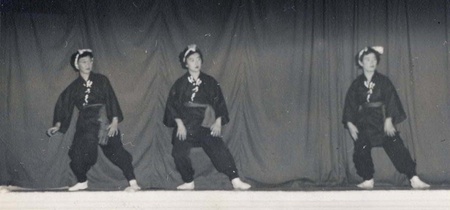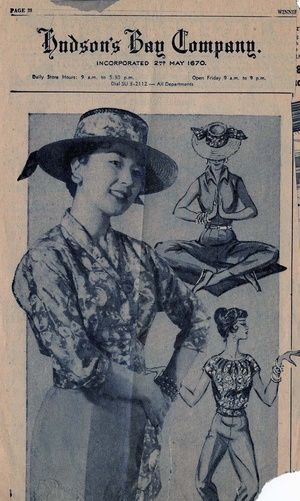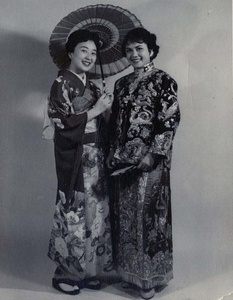How was growing up and living in Winnipeg different than other places in Canada? What kind of interaction between immigrant groups do you recall? Ukrainians, Mennonites, and First Nations?
Finally, restrictions were lifted on April 1, 1949, some seven years after our internment, and more than four years after the end of the Pacific War. Asian Canadians were allowed to vote federally in June 1948, and provincially a year later.
But of course most Japanese Canadians now living ‘dispersed’ across the country still living in a survival mode did not have the wherewithal to return to the West Coast to begin their lives over again. For my parents, who were young and struggling to get their family life together before the war, it was a huge struggle to begin anew anywhere with four school aged children and one living in Japan who they must still bring home.
Already living in rural Manitoba, it was natural step to take to move into the City of Winnipeg, trusting this move will give them opportunities to build a new life.
Some Japanese Canadian families were already living in Winnipeg when we moved there in 1950, and there was an advisory group like the JCCA (Japanese Canadian Citizens Association) in place, and there was support particularly coming from the large Jewish community which exists in Winnipeg. With assistance from a Jewish landlord we were able to rent a house, and with a Jewish employer, my father was able to get a job in a tannery. My mother, too, began working as a seamstress in a Jewish sewing factory where already many Japanese Canadian women were hired. Their total focus was on settling the children into schools, and to eventually afford to pay the mortgage on a house that we can finally call our own.

I was introduced to a high school in the north end of Winnipeg, St. John’s Technical High School, as it was called in those days. The north end was largely a Jewish district, and there were also many Scandinavian, Ukrainian, and Polish students in this school. It was a totally new experience for me as I had never been to a large school in a city before. I spent two years here, graduating after grade eleven. Instead of going to university, which was not an option, I spent the next year going to Success Business College. My sister had returned from Japan to us in 1951, and she began working toward improving her English and toward training for a job.
My first job as a stenographer was with an insurance company. Hiring me was this company’s first experience with a Japanese Canadian. I was given a lot of support by staff and by the bosses. I subsequently moved to The Anthes Imperial Company, a cast iron pipe foundry, where many Japanese Canadian men found work, and so when I was hired there as a stenographer and later became the Vice President’s secretary, there was much happiness among our community. My boss, the late David Russell, who eventually moved to the head office in St. Catherines, Ontario, was someone who, together with his wife, introduced me to various aspects of a Western life, something my parents were not able to give me. They took me to Winnipeg Symphony Orchestra concerts, to Winnipeg Blue Bomber games, etc., and when I decided to go to Vancouver for a year, he arranged for me from St. Catharines, a job in the Steno Pool of B. C. Electric through his connections. He remains with me to this day as someone who gave me courage to move forward in life as a Canadian.
I began in my teens to take interest in Japanese Canadian social events and various functions. There was already formed at the local YWCA, a group called the Niseiettes, formed by young adults (which I joined when I was a little older) regularly meeting and organizing social events.
There were also the annual Christmas banquet and dance, held at a local hotel, and as I grew older and was invited to these formal events, I remember annually my mother designing and sewing beautiful gowns for me to wear.
There were also the annual concerts, called shibai, as they were called, where local talents were displayed, including Japanese dance or odori, martial arts, music and song performances, including comedy, etc.
My parents were actively involved in the Manitoba Buddhist Church which was built very soon after the end of the internment, and my older sister taught Japanese in classes that were held there. I was attending Knox United Church, singing in the choir.
Through this all what was your connection to your parents and Japan? Do you read, write, and speak Japanese? How did you maintain this connection through the years?
While I did not think so at the time, I had throughout my childhood a strict mother who, particularly during the internment years in Minto, made me sit at the kitchen table daily after public school to continue my Japanese language lessons. I was in grade two at Vancouver’s Japanese Language School on Alexander Street, when we left Vancouver. I remember feeling very angry and upset that I had to attend her class while my friends were outside playing, and more, that afterward. I thank her today for her perseverance as I have retained and continue to add to what she had taught me. I appreciate that the majority of Nisei my age can hardly speak or read Japanese, if at all.
But at that time, I felt a bit of a misfit as I was singing Japanese songs with my mother at home, while my classmates knew the latest Hit Parade songs. I envied them for having older siblings to teach them.
However, when the Consulate General opened in Winnipeg, in the early `50s (not sure of the date), which I believe was the first post-war Consulate, due to the wheat trade, I was very much in demand as a young Canadian woman with ability to speak Japanese, and was invited to various functions including when the President of the Skating Union of Japan, Mr. Tsuneyoshi Takeda, brought a team to play hockey against the Kenora (Ontario) Thistles in 1956. He was related to the Showa Emperor, but lost his title Prince with the American Occupation. Interestingly when the Winter Olympics was held here in Vancouver, a few years ago, I met his son, Mr. Tsunekazu Takeda, President of Japan’s Olympic Commission. Another invitation I received from the Consulate was to a private dinner in honour of a visit by the Ambassador, Mr. Matsudaira, appointed to New York, who stopped in Winnipeg on his way to his new appointment.
I might mention here that when Japanese Canadians began moving into Winnipeg, there was great interest in us by media, like CBC, based, I believe on exoticism (photos mostly of women wearing kimono) but since we were being accepted into this `new world’, we obliged and responded to a lot of press coverages.
Can you describe then your evolution as an artist/curator? When did your interest in art begin?
Of course, it depends on what one calls ‘art’, but for me, it was always there in my everyday life, as something normal, not recognized as ‘art’ per se, but a way of life offered to me by my environment, and earlier by my mother. It was labelled as such formally after I began art education through university studies, much later in life.
When I say art was in my everyday growing life, I am referring to the fact that my mother was the constant in my life. She represented art, set an example, even as I had not thought about this for many years. Whenever she had any spare time, she would be writing or reading, practicing calligraphy. I remember in Minto that she went out and peeled birch bark from trees, and writing poetry on them, to send to her sister (not sure if she actually sent them). She planted flowers along the edge of the vegetable garden and brought flowers into the house and carefully arranged them. But where she excelled was in designing clothes. All our clothes were made by her. I never thought anything of this, as in those days all mothers sewed. But I became very impressed with her artistic skills in Winnipeg, when in my late teens into early twenties, she began designing and sewing gowns for me to wear as I began to be invited to Christmas balls and to university proms. I recall she would, with a flourish, throw a heavy roll of brown paper on the floor, and with a wooden square (which she treasured and did not allow us children to touch), begin measuring out the pattern to fit the style she had chosen (usually special, vogue-like). I was always dressed like a princess to go to these events, and in retrospect, I believe I was her `Barbie doll’ in those days!
So, I did not think she was making art, but believe my own sense of design and appreciation for art originates here.
In the 1950s, soon after we moved into Winnipeg, and I was moving into adulthood, among the various activities was the annual shibai, a concert of local Japanese talents, held in the early days usually at the Ukrainian Labour Temple hall. Together with my sister and a friend, the three of us, having been taught odori by a friend of the family, Mrs. Asako Oye, an older woman, who played the shamisen and sang, we performed at these events.

In those days, my older sister, who was raised in Japan, knew all the latest Japanese pop songs, and so she would teach me and my mother. We would sing these songs as we washed and dried the daily dishes. In time, I (who used to sing in church choirs) began singing solo, Japanese songs at the annual concert, very unusual for a Nisei, even in those days.

There were, also, during this period several young Japanese Canadian men interested in photography, and so we were always getting our pictures taken by them. In fact, for me, I began to be invited to model for them, but also for media and in one instance, by Hudson Bay Company which (through the Consulate General’s suggestion) requested me to wear a line of clothing and appear in their advertisement in the Winnipeg Free Press. I believe this interest in a Japanese Canadian woman was about exoticism, a first time experience of Asian women in Winnipeg.
So one might say, these activities were the beginning of my art career, perhaps more in the line of `performance’ something not spoken about except on stage, in those days.
© 2016 Norm Ibuki











